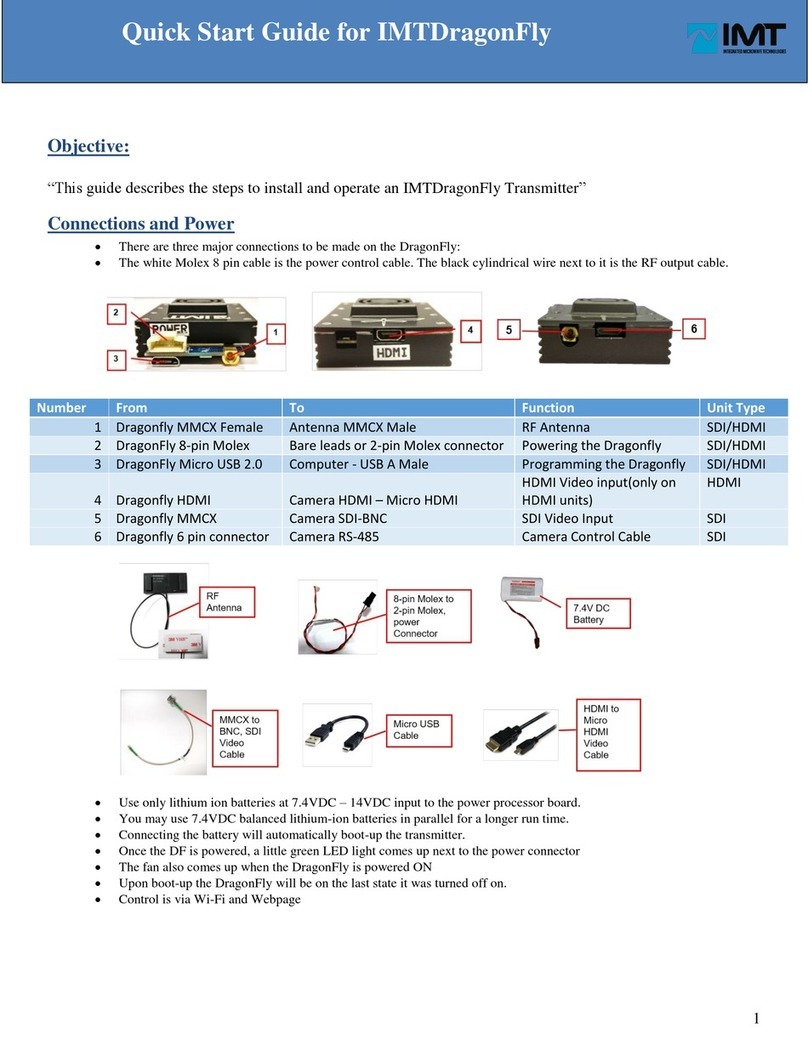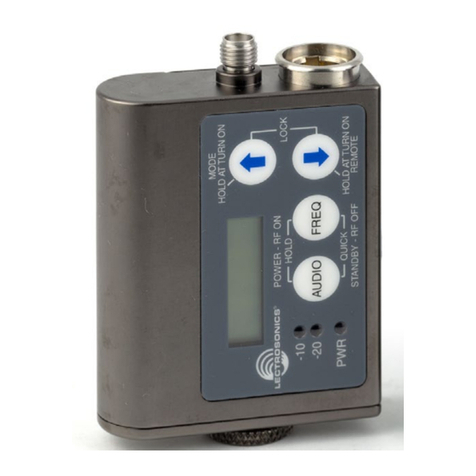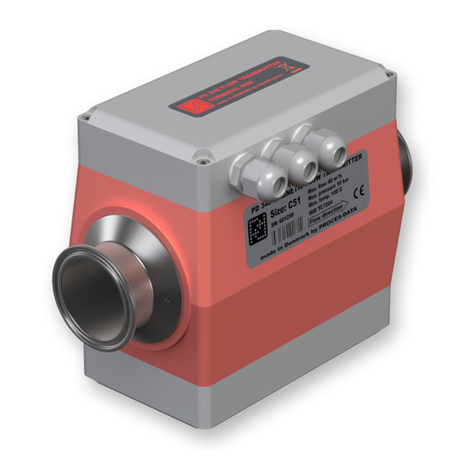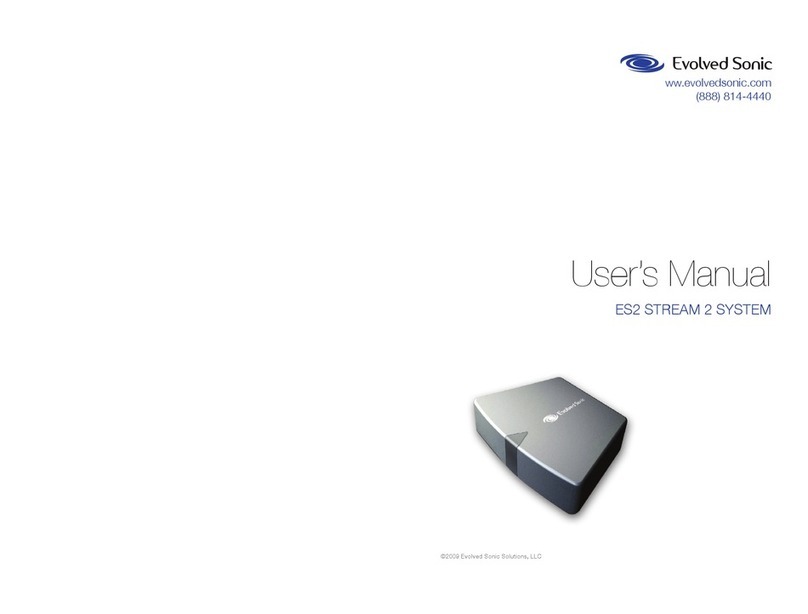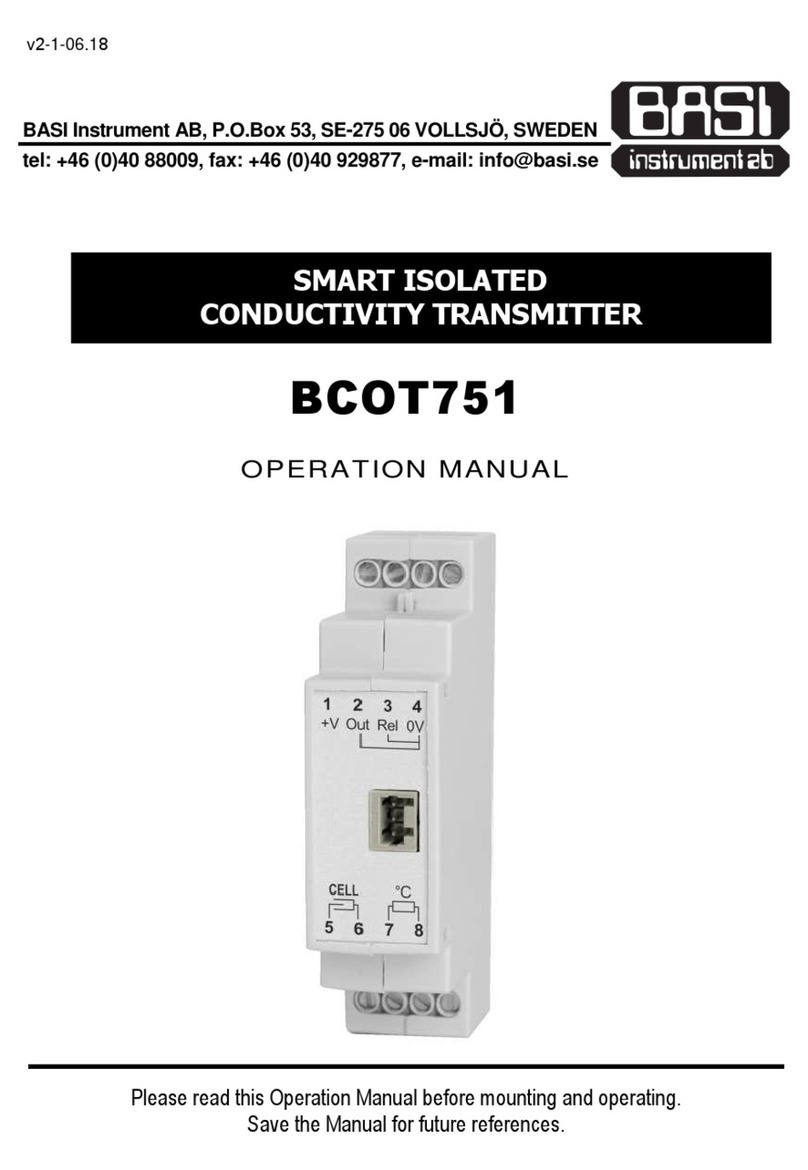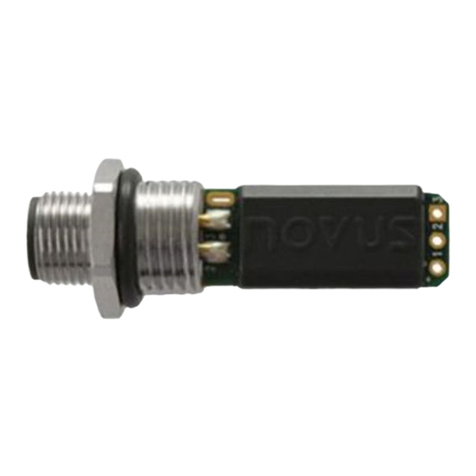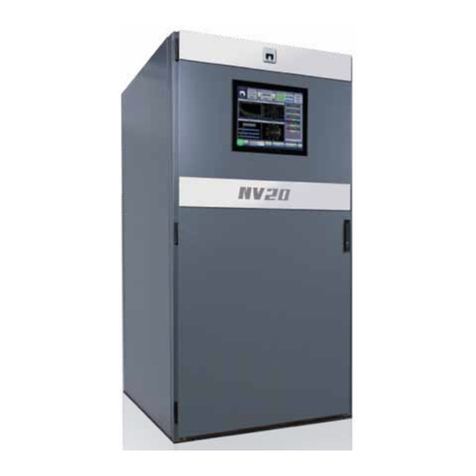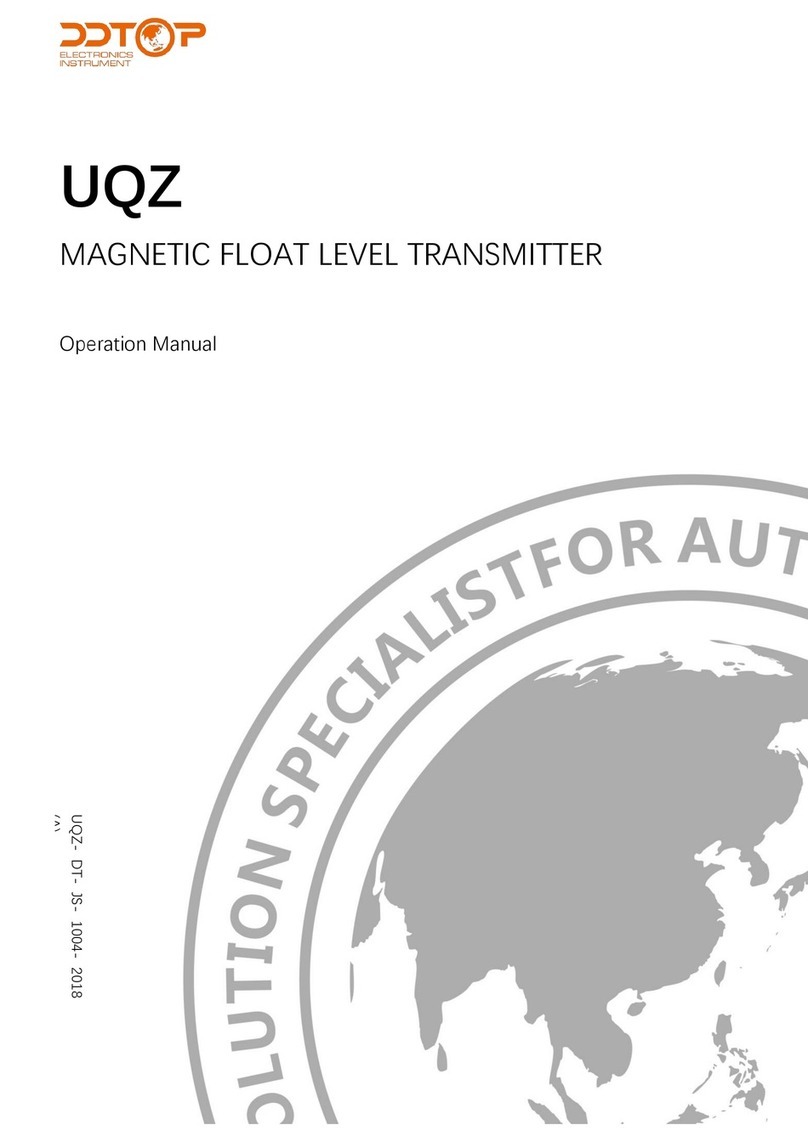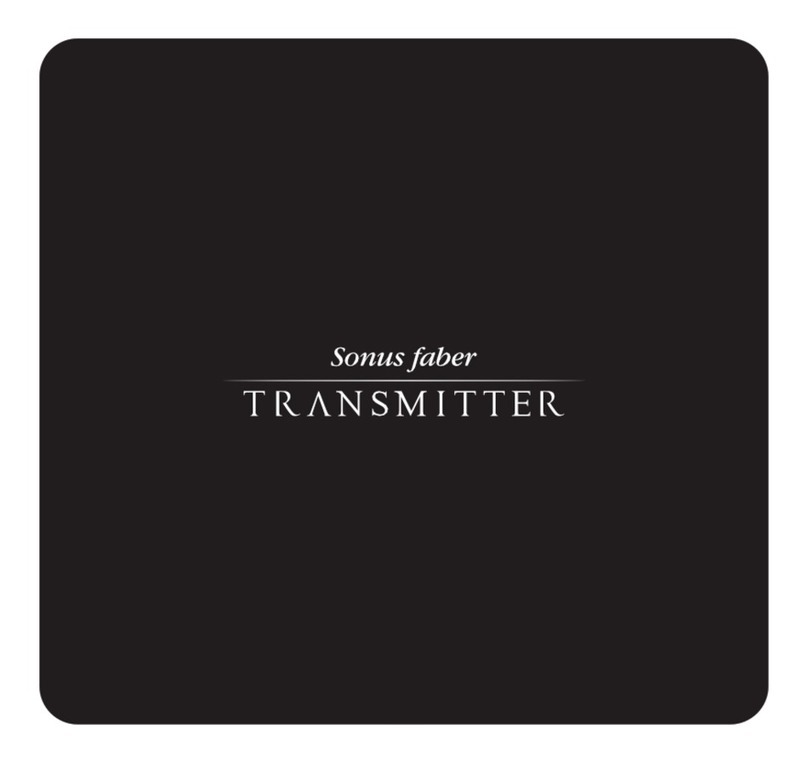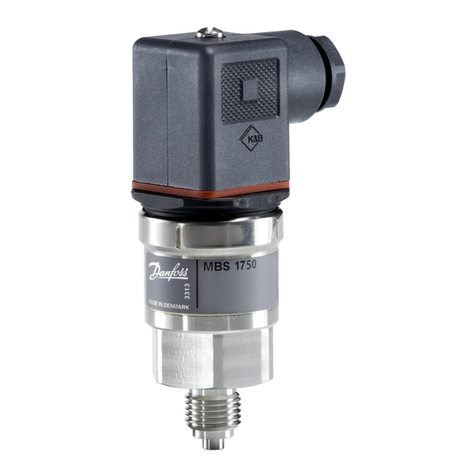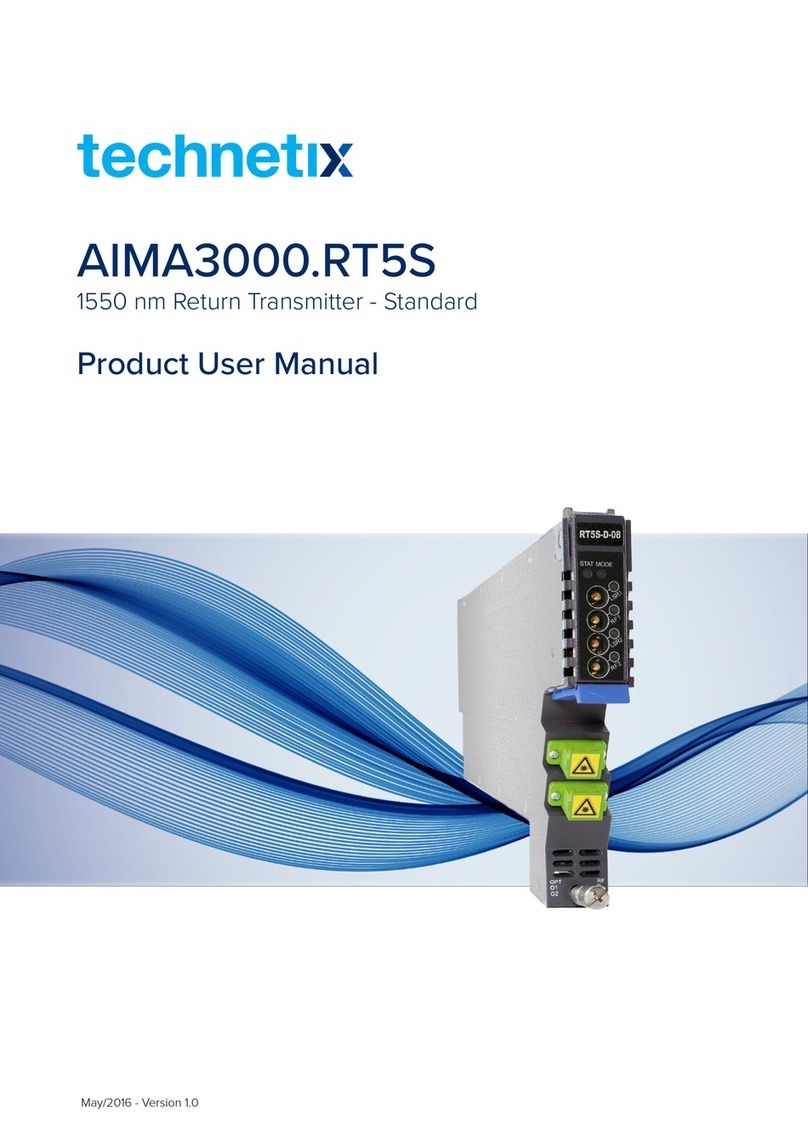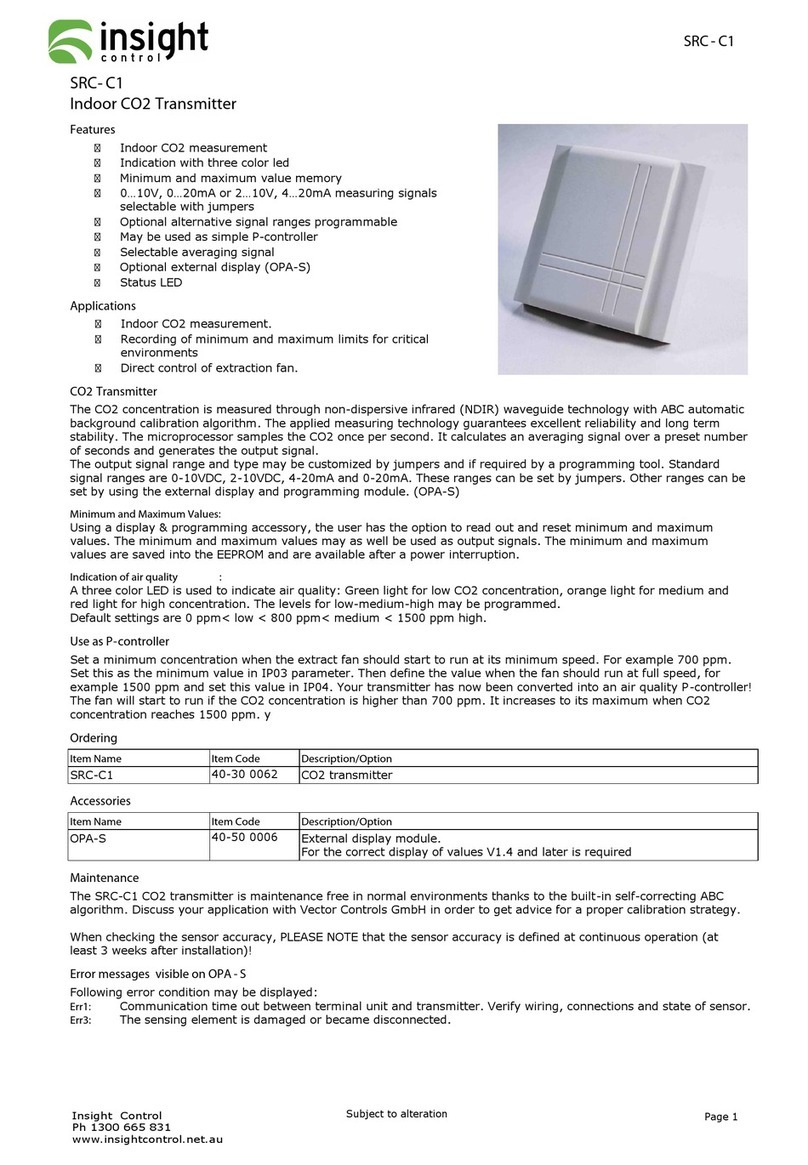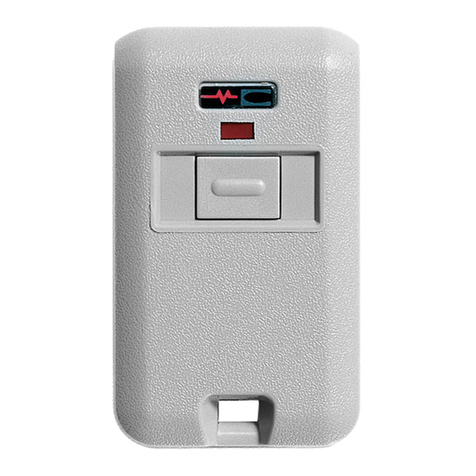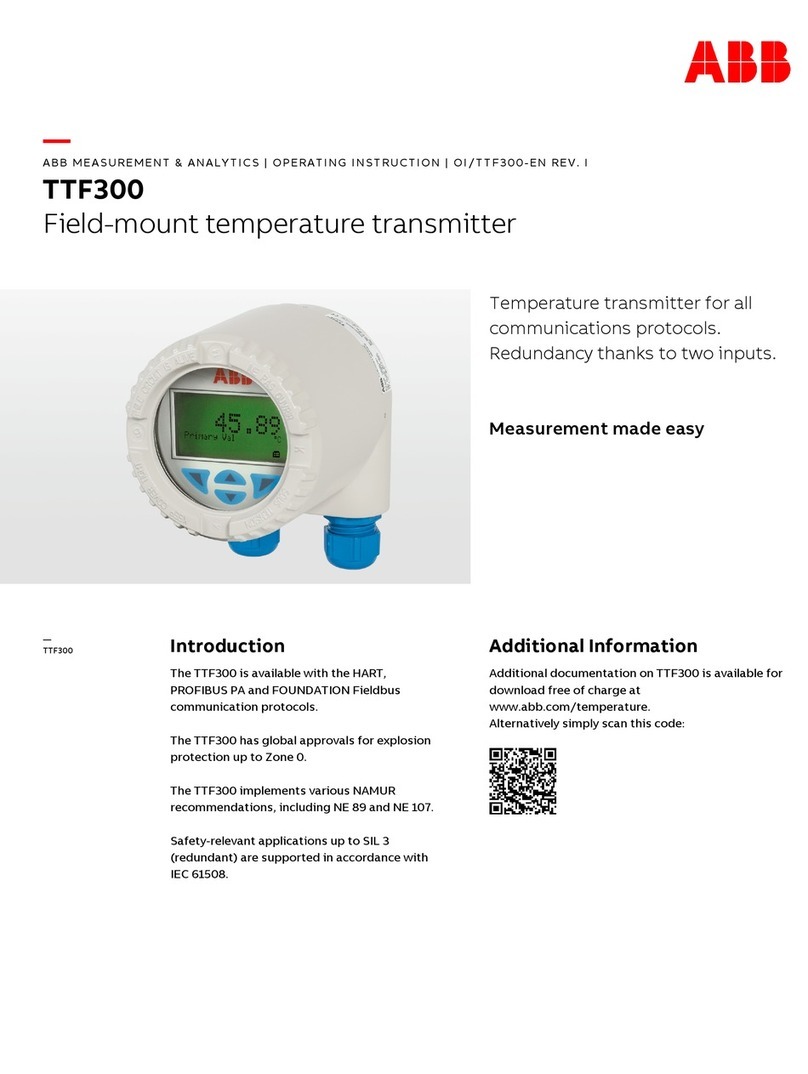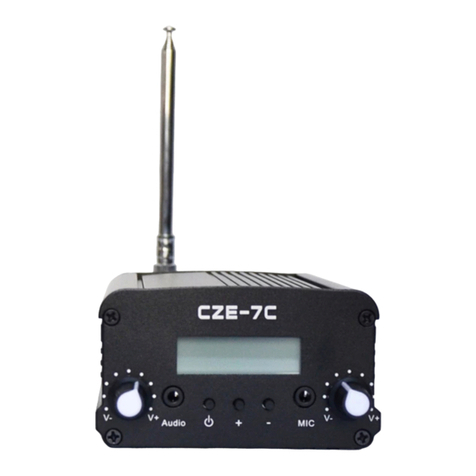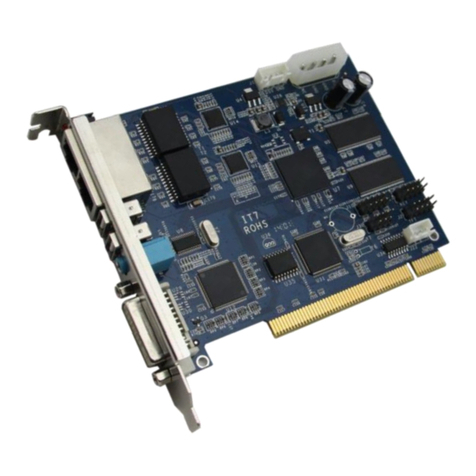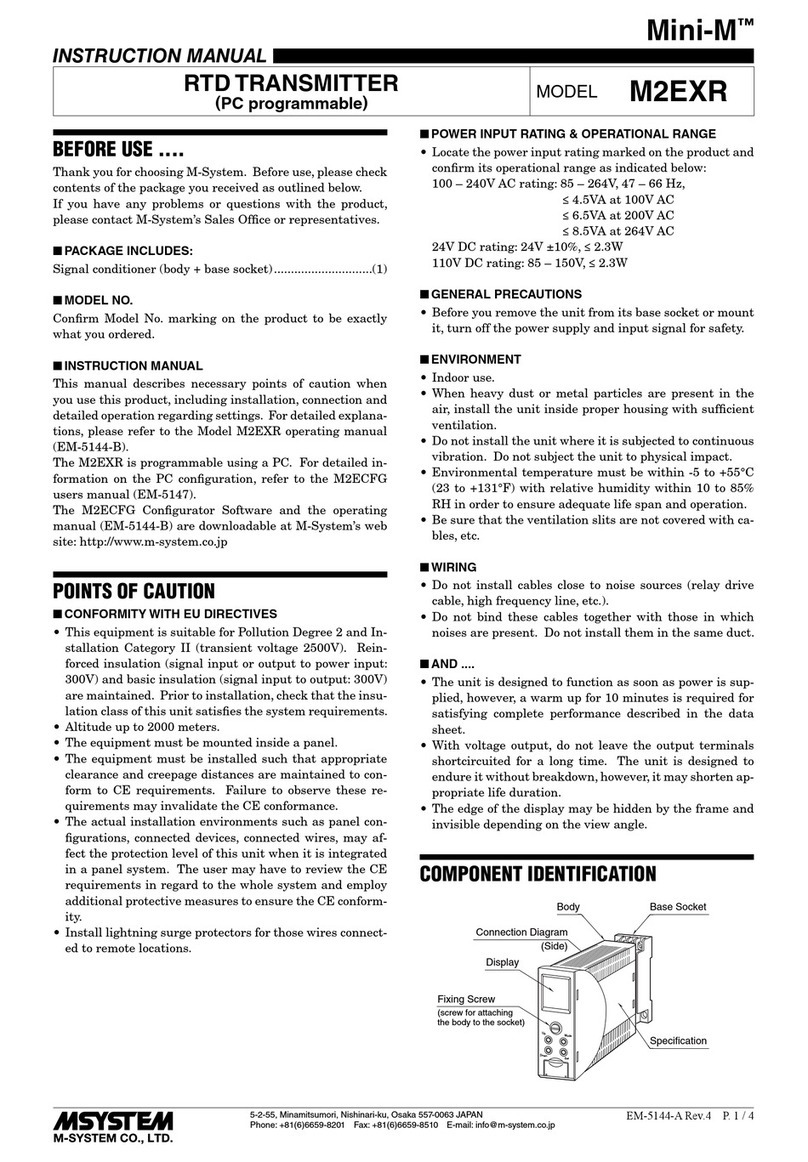IMT VSTx User manual

VSTX
HD/SD COFDM Transmitter
User Manual
IMT PUBLICATION: M22-0002-00A, REV 2.3

VSTXUser Manual
Revision 2.32
Revision History
Date
Revision
Modified By
Description
October 1, 2009
1.0
JB
Initial release
October 12. 2011
1.1a
Mike Hardy
Major Update and cleanup. Removed ASI/SDI.
October 27. 2011
1.1b
Mike Hardy
Updated ribbon table
November 28. 2011
2.0
Sean Van
Update
December 19. 2011
2.1
Alexander
Minicozzi
Jason provided FCC and IC Statements
January 10. 2012
2.2
Jason Wang
Added FCC & IC Label requirements
January 25. 2012
2.3
Jason Wang
Added RP-SMA Antenna Port for 25VST
IMT VSTX
Users Manual
IMT Publication: M22-0002-00A
IMT, LLC.
200 International Drive
Mt. Olive, NJ, 07828, USA.
T +1 908 852 3700 F +1 908 813 0399
www.imt-solutions.com
We make every effort to ensure our documentation is as accurate and as complete as possible. In the event that you find any errors or
omissions, please contact Customer Tech Support at (908) 852-3700, or via email a service@nucomm.com.
© Copyrighted 2011 - IMT, LLC - Mount Olive, New Jersey 07828

VSTXUser Manual
Revision 2.33
This product has been approved by the following regulatory bodies at 2400 –2483.5
MHz:
FCC (USA)
IC (Canada)
CAUTION!
RISK OF ELECTRICAL SHOCK.
DO NOT REMOVE COVERS.
Do not remove any covers
Refer servicing to qualified
technicians only
Disconnect all power before
servicing
Read and perform all
instructions carefully
Failure to follow suggested
instructions and guidelines may
void all warranties
PRUDENCE!
RISQUE DE CHOC ÉLECTRIQUE. NE
SUPPRIMEZ PAS LES COUVERTURES.
Ne supprimez pas les couvertures
Voir entretien à qualifiés Techniciens
seulement.
Déconnectez tous les pouvoir avant
l'entretien.
Lecture et effectuer toutes les instructions
attentivement.
Échec de suivre les lignes directrices et les
instructions proposées peut-être annuler
toutes les garanties.

VSTXUser Manual
Revision 2.34
FCC CAUTION/ PRUDENCE DE FAC
Any change or modification not approved by the party responsible for compliance could void the user’s authority to operate
this device.
This device requires professional installation.
For operation within 2400 –2483.5 MHz frequency range, the maximum EIRP must be less than 36 dBm. The qualified
antenna types to be used with this device include:
dipole antenna (3dBi or 5dBi)
This device complies with Part 15 of the FCC Rules. Operation is subject to the following two conditions: (1) This device
may not cause harmful interference, and (2) this device must accept any interference received, including interference that
may cause undesired operation.
In order to maintain compliance with the FCC RF exposure guidelines, this device should be installed and operated with a
minimum distance of 20cm between the radiator, and the body of the operator and/or nearby persons.
Tout changement ou modification non approuvé par la partie responsable de la conformité pouvait annuler l'autorisation de
l'utilisateur pour l'exploitation de ce dispositif.
Ce dispositif nécessite l'installation professionnelle.
Pour l'opération au sein de la gamme de fréquences de 2400 –2483.5 MHz, la pire maximale doit être inférieure à 36 dBm.
Les types d'antenne qualifiés pour être utilisé avec ce dispositif, citons :
Antenne dipôle faible Gain (3dBi ou 5 dBi).
Cet appareil est conforme à la partie 15 des règles de la FCC. Opération est soumis à deux conditions suivantes: (1) ce
dispositif ne peut pas causer de brouillage préjudiciable, et (2) ce dispositif doit accepter toute ingérence a reçu, y compris
le brouillage qui peut provoquer l'opération non désirée.
Afin de maintenir la conformité avec les directives d'exposition RF FCC, ce dispositif doit être installé et exploité avec une
distance minimale de 20 cm entre le radiateur et le corps de l'opérateur ou à proximité de personnes.
FCC STATEMENT
This equipment (FCC ID: I4U-25VST) has been tested and found to comply with the
limits for a Class B digital device, pursuant to part 15 of the FCC Rules.
DÉCLARATION DE FAC
Cet équipement (FCC ID: I4U-25VST) a été testé et de respecter les limites pour une
classe b dispositif numérique, conformément à la partie 15 des règles de la FCC.

VSTXUser Manual
Revision 2.35
IC Notice/:IC Avis
1. Under Industry Canada regulations, this radio transmitter may only operate using an antenna of a type
and maximum (or lesser) gain approved for the transmitter by Industry Canada. To reduce potential
radio interference to other users, the antenna type and its gain should be so chosen that the equivalent
isotropically radiated power (e.i.r.p.) is not more than that necessary for successful communication.
Conformément à la réglementation d'Industrie Canada, le présent émetteur radio peut
fonctionner avec une antenne d'un type et d'un gain maximal (ou inférieur) approuvé pour
l'émetteur par Industrie Canada. Dans le but de réduire les risques de brouillage
radioélectrique à l'intention des autres utilisateurs, il faut choisir le type d'antenne et son gain
de sorte que la puissance isotrope rayonnée équivalente (p.i.r.e.) ne dépasse pas l'intensité
nécessaire à l'établissement d'une communication satisfaisante.
2. This radio transmitter (IC: 9479A-25VST) has been approved by Industry Canada to operate with the
antenna types listed below with the maximum permissible gain and required antenna impedance for
each antenna type indicated. Antenna types not included in this list, having a gain greater than the
maximum gain indicated for that type, are strictly prohibited for use with this device.
Le présent émetteur radio (identifier le dispositif par son numéro de certification ou son
numéro de modèle s'il fait partie du matériel de catégorie I) a été approuvé par Industrie
Canada pour fonctionner avec les types d'antenne énumérés ci-dessous et ayant un gain
admissible maximal et l'impédance requise pour chaque type d'antenne. Les types d'antenne
non inclus dans cette liste, ou dont le gain est supérieur au gain maximal indiqué, sont
strictement interdits pour l'exploitation de l'émetteur.
Antenna Approved/Antenne approuvé
Type/Type
Max. Gain/Max.
Gain
Impedance/Impédance
Dipole Antennas/
dipôle antennes
5 dBi
50 Ω
3. This device complies with Industry Canada licence-exempt RSS standard(s). Operation is subject to the
following two conditions: (1) this device may not cause interference, and (2) this device must accept
any interference, including interference that may cause undesired operation of the device.
Le présent appareil est conforme aux CNR d'Industrie Canada applicables aux appareils radio
exempts de licence. L'exploitation est autorisée aux deux conditions suivantes : (1) l'appareil
ne doit pas produire de brouillage, et (2) l'utilisateur de l'appareil doit accepter tout brouillage
radioélectrique subi, même si le brouillage est susceptible d'en compromettre le
fonctionnement.
4. In order to maintain compliance with the IC RF exposure guidelines, this device should be installed and
operated with a minimum distance of 20 cm between the radiator, and the body of the operator and/or
nearby persons.

VSTXUser Manual
Revision 2.36
Afin de maintenir la conformité avec les directives d'exposition RF IC, ce
dispositif doit être installé et exploité avec une distance minimale de 20
cm entre le radiateur et le corps de l'opérateur ou à proximité de
personnes.
FCC / IC Label Requirement
If the FCC /IC ID is not visible when the I4U-25VST / 9479A-25VST module is installed inside another OEM
device, then the outside of the OEM device into which the module is installed must also display a label referring to
the enclosed module. This exterior label can use wording such as the following: “Contains Transmitter Module
FCC ID: I4U-25VST”/ IC: 9479A-25VST”or “Contains FCC ID: I4U-25VST. / IC: 9479A-25VST” Any similar
wording that expresses the same meaning may be used.
FAC / IC Label exigence
SI LE FCC /IC ID N'EST PAS VISIBLE LORSQUE LA I4U-25VST /9479A-25VST MODULE EST INSTALLÉ À
L'INTÉRIEUR D'UN AUTRE PÉRIPHÉRIQUE OEM, ALORS QUE L'EXTÉRIEUR DE L'APPAREIL OEM DANS LEQUEL
EST INSTALLÉ LE MODULE DOIT ÉGALEMENT AFFICHER UNE ÉTIQUETTE SE RÉFÉRANT AU MODULE CI-JOINT.
CETTE ÉTIQUETTE EXTÉRIEURE PEUT UTILISER LIBELLÉ COMME SUIT:"CONTAINS ÉMETTEUR MODULE ID
FCC: I4U-25VST" /IC: 9479A-25VST "OU"CONTAINS FCC ID: I4U-25VST. /IC: 9479A-25VST "TOUTE
FORMULATION SEMBLABLE QUI EXPRIME LE MÊME SENS PEUT-ÊTRE ÊTRE UTILISÉE.

VSTXUser Manual
Revision 2.37
Contents
1
Introduction
...............................................................................................................................14
1.1 Manual Overview...........................................................................................................................14
2
VSTXDescription
......................................................................................................................16
2.1 VSTXFeatures and Benefits.......................................................................................................16
2.1.1 VSTXApplication Diagram........................................................................................................................... 17
2.1 VSTXTheory of Operation ..........................................................................................................18
2.1.1 VSTXBlock Diagram..................................................................................................................................... 18
2.1.2 Power and Control Interface Connector ................................................................................................... 20
2.1.3 Audio and Video Input Connectors............................................................................................................ 20
2.1.4 User Data Input............................................................................................................................................ 20
2.1.5 MPEG4 Encoder ............................................................................................................................................ 20
2.1.6 Encryption ..................................................................................................................................................... 20
2.1.7 COFDM Modulator ........................................................................................................................................ 20
2.1.8 L, S, and C Band Transmitter.................................................................................................................... 21
2.1.9 Ultra Compact Case ..................................................................................................................................... 21
2.1 Remote Control and Firmware.................................................................................................21
2.1.1 Remote Control via Serial Interface .......................................................................................................... 21
2.1.2 Firmware updates ........................................................................................................................................ 21
3
Specifications
............................................................................................................................24
3.1 Frequency Bands ...........................................................................................................................24
3.2 Modulation Modes.........................................................................................................................24
3.3 MPEG Encoder ................................................................................................................................25
3.4 System...............................................................................................................................................25
3.5 Power Requirements ...................................................................................................................25
3.6 Environmental ................................................................................................................................26
3.7 Physical Specifications................................................................................................................26
4
Installation
.................................................................................................................................28
4.1 Overview ..........................................................................................................................................28
4.2 Identifying VSTXPhysical Features and Interfaces .........................................................29
4.2.1 Connector Housing....................................................................................................................................... 29
4.2.2 Ribbon Housing ............................................................................................................................................ 31
4.3 Physical Installation ....................................................................................................................32
4.4 Connect External Signals (Connector Housing).................................................................33
4.4.1 Power and Control (Connector Housing) .................................................................................................. 33
IMT part # ..................................................................................................................................................................... 33
Cable Description.......................................................................................................................................................... 33
CableType ..................................................................................................................................................................... 33
7pin LEMO to bare tin strip leads ................................................................................................................................. 33
Power Input cable ......................................................................................................................................................... 33
7pin LEMO to bare tin strip leads, w/DB9 .................................................................................................................... 33

VSTXUser Manual
Revision 2.38
Power Input cable (w/Control) ..................................................................................................................................... 33
4.4.2 Video Input (Connector Housing) .............................................................................................................. 35
4.4.3 Audio Input (Connector Housing) .............................................................................................................. 35
4.5 Connect External Signals (Ribbon Housing).......................................................................35
4.6 Antenna Installation ....................................................................................................................36
5Operation........................................................................................................................................38
5.1 Power Up the VSTX.......................................................................................................................38
5.2 Pre-Configure the VSTX user options ....................................................................................38
5.3 User Interfaces ..............................................................................................................................39
5.3.1 Button & LED Interface ............................................................................................................................... 39
5.3.2 Rotary/Key Interface ................................................................................................................................... 40
5.3.3 Ribbon Version.............................................................................................................................................. 41
5.3.3.1 PA AGC Signal ..................................................................................................................................... 42
5.3.3.2 RS232 RX UD....................................................................................................................................... 42
5.3.3.3 RS232 Remote Control RS-232 Tx / Rx........................................................................................... 42
5.3.3.4 USB_PWR............................................................................................................................................. 42
5.3.3.5 USB_DP/USB_DM................................................................................................................................ 42
5.3.3.6 Composite Video ................................................................................................................................. 42
5.3.3.7 +12VDC................................................................................................................................................ 42
5.3.3.8 Audio 1, Audio 2 Inputs..................................................................................................................... 42
5.4 Using the VSTXto Transmit Audio and Video Signals......................................................43
5.4.1 Select User Level Settings........................................................................................................................... 43
5.4.2 Put the unit in Transmit Mode.................................................................................................................... 43
5.4.3 Select Power Level ....................................................................................................................................... 43
5.4.4 Verify Operation ........................................................................................................................................... 43
5.5 Using the VSTXTo Transmit User Data (Ribbon version only).....................................43
5.6 Using alternate/custom controllers.......................................................................................44
5.6.1 Serial Interface Rate, Parity, and Stop Bit Specifications....................................................................... 44
5.6.2 Command and Response Packet Formats ................................................................................................ 44
5.7 Troubleshooting.............................................................................................................................45
5.8 Maintenance Information ..........................................................................................................45
1Introduction .....................................................................................................................................8
1.1 Manual Overview................................................................................................................................. 8
2VSTx Description...........................................................................................................................10
2.1 VSTx Features and Benefits..............................................................................................................10
2.1.1 VSTx Application Diagram............................................................................................................................ 11
2.1 VSTx Theory of Operation ...............................................................................................................12
2.1.1 VSTx Block Diagram..................................................................................................................................... 12
2.1.2 Power and Control Interface Connector ......................................................................................................... 14
2.1.3 Audio and Video Input Connectors................................................................................................................ 14
2.1.4 User Data Input............................................................................................................................................... 14
2.1.5 MPEG4 Encoder............................................................................................................................................. 14
2.1.6 Encryption ...................................................................................................................................................... 14
2.1.7 COFDM Modulator........................................................................................................................................ 14
2.1.8 L, S, C, and X Band Transmitter .................................................................................................................... 15

VSTXUser Manual
Revision 2.39
2.1.9 Ultra Compact Case........................................................................................................................................ 15
2.1 Remote Control and Firmware ........................................................................................................15
2.1.1 Remote Control via Serial Interface ............................................................................................................... 15
2.1.2 Firmware updates ........................................................................................................................................... 15
3Specifications.................................................................................................................................18
3.1 Frequency Bands ...............................................................................................................................18
3.2 Modulation Modes.............................................................................................................................18
3.3 MPEG Encoder..................................................................................................................................19
3.4 System.................................................................................................................................................19
3.5 Power Requirements..........................................................................................................................19
3.6 Environmental....................................................................................................................................20
3.7 Physical Specifications....................................................................................................................... 20
4Installation.....................................................................................................................................22
4.1 Overview.............................................................................................................................................22
4.2 Identifying VSTx Physical Features and Interfaces.......................................................................23
4.2.1 Connector Housing......................................................................................................................................... 23
4.2.2 Ribbon Housing.............................................................................................................................................. 25
4.3 Physical Installation........................................................................................................................... 26
4.4 Connect External Signals (Connector Housing) ............................................................................. 27
4.4.1 Power and Control (Connector Housing) ....................................................................................................... 27
4.4.2 Video Input (Connector Housing) .................................................................................................................. 29
4.4.3 Audio Input (Connector Housing).................................................................................................................. 29
4.5 Connect External Signals (Ribbon Housing)...................................................................................29
4.6 Antenna Installation..........................................................................................................................30
5Operation........................................................................................................................................32
5.1 Power Up the VSTx...........................................................................................................................32
5.2 Pre-Configure the VSTX user options.............................................................................................32
5.3 User Interfaces...................................................................................................................................33
5.3.1 Button & LED Interface ................................................................................................................................. 33
5.3.2 Rotary/Key Interface ...................................................................................................................................... 34
5.3.3 Ribbon Version............................................................................................................................................... 35
5.3.3.1 PA AGC Signal..................................................................................................................................... 36
5.3.3.2 RS232 RX UD ...................................................................................................................................... 36
5.3.3.3 RS232 Remote Control RS-232 Tx / Rx............................................................................................... 36
5.3.3.4 USB_PWR............................................................................................................................................ 36
5.3.3.5 USB_DP/USB_DM .............................................................................................................................. 36
5.3.3.6 Composite/S-Video............................................................................................................................... 36
5.3.3.7 +12VDC................................................................................................................................................ 36
5.3.3.8 Audio 1 With Bias ................................................................................................................................ 36
5.3.3.9 Audio 2 With Bias ................................................................................................................................ 36
5.3.3.10 Audio 1, Audio 2 Inputs........................................................................................................................ 36
5.4 Using the VSTx to Transmit Audio and Video Signals..................................................................37
5.4.1 Select User Level Settings.............................................................................................................................. 37

VSTXUser Manual
Revision 2.310
5.4.2 Put the unit in Transmit Mode........................................................................................................................ 37
5.4.3 Select Power Level......................................................................................................................................... 37
5.4.4 Verify Operation............................................................................................................................................. 37
5.5 Using the STx To Transmit User Data.............................................................................................37
5.6 Using alternate/custom controllers...................................................................................................38
5.6.1 Serial Interface Rate, Parity, and Stop Bit Specifications .............................................................................. 38
5.6.2 Command and Response Packet Formats....................................................................................................... 38
5.7 Troubleshooting.................................................................................................................................39
5.8 Maintenance Information ................................................................................................................. 39

VSTXUser Manual
Revision 2.311
Figures
Figure 2-1: VSTXApplication______________________________________________________________________ 18
Figure 2-2: Nucomm VSTXInternal Block Diagram ___________________________________________________ 19
Figure 2-3 - Encryption Circuit_____________________________________________________________________ 20
Figure 4-1: VSTXApplication With Optional Host Processor___________________________________________ 28
Figure 4-2: VSTx –Connector Housing (Button & LED version shown)__________________________________ 29
Figure 4-3: VSTX –Button & LED faceplate _________________________________________________________ 30
Figure 4-4: VSTX –Rotary/Key faceplate____________________________________________________________ 30
Figure 4-5: VSTx - Ribbon Housing________________________________________________________________ 31
Figure 4-6: VSTXOutline Drawing, Connector Housing (Dimensions in Inches)___________________________ 32
Figure 4-7: VSTx (Connector Housing) Power/Control Detail __________________________________________ 34
Figure 4-8: VSTx (Connector Housing) Audio Detail __________________________________________________ 35
Figure 5-1: VSTx –Button & LED interface__________________________________________________________ 39
Figure 5-2: VSTX –Rotary/Key interface ____________________________________________________________ 40
Figure 5-3: VSTx - Ribbon Version interface ________________________________________________________ 41
Tables
Table 2-1: VSTX- Summary of High Level Features and Benefits ______________________________________ 16
Table 4-1: VSTx (Connector Housing) Power/Control Cables __________________________________________ 33
Table 4-2: VSTx (Connector Housing) Power/Control Pinout___________________________________________ 34
Table 4-3: VSTx (Connector Housing) Audio Pinout __________________________________________________ 35
Table 4-4: Ribbon Cable Connector Cable Pin Assignments___________________________________________ 36
Table 5-1: Table of Troubleshooting Tips ___________________________________________________________ 45

VSTXUser Manual
Revision 2.312

VSTXUser Manual
Revision 2.313
Chapter One
1
Introduction

VSTXUser Manual
Revision 2.314
1Introduction
This document is a user manual for IMT’s VSTXmicrowave video transmitter. The VSTXis a
compact transmitter that digitally encodes video signals and transmits them using COFDM
modulation over microwave frequencies using secure methods. The unit accepts Composite
video inputs in NTSC or PAL format. It has a built in MPEG4 (H.264) encoder and COFDM
modulator. The VSTXis housed in an ultra compact, lightweight enclosure that can be used
in harsh environments.
The VSTx comes in two versions, a “connectorized” version which has connectors for typical
user inputs and outputs and a user interface panel, and a “ribbon cable” version which has
no external connectors or controls.
Throughout this manual, the product is referred to as the “VSTX,” the “VSTX transmitter”, or
simply the “transmitter.”
1.1 Manual Overview
The contents of this manual are as follows:
Chapter 2 –Describes the theory of operation and the features of the VSTX.
Chapter 3 –Contains a list of the VSTXspecifications. The specifications include
transmitter feature specifications, power requirements, environmental
specifications, and I/O specifications.
Chapter 4 –Explains how to install the VSTX.
Chapter 5 –Describes operating procedures for the VSTX. It also contains an overview
of the VSTXprogrammable serial interface.
A preface at the front of this manual contains Warranty and Repair information.
The rear of this manual contains warranty and repair information.

VSTXUser Manual
Revision 2.315
Chapter Two
2
Description

VSTXUser Manual
Revision 2.316
2VSTXDescription
This chapter describes the VSTXtransmitter theory of operation, features, and benefits. It also contains
a block diagram of the VSTXtransmitter circuitry and a typical application example.
The VSTx is available in two basic versions:
VSTx with external input connectors
VSTx with ribbon cable interface
The VSTx with external connectors features direct plug-in compatibility with off the shelf equipment
using industry standard interfaces.
The VSTx using a ribbon cable interface is slightly smaller and is useful for space optimized solutions.
Audio and Video are input to the VSTXthrough the ribbon cable. A programmable user interface is
also accessed via a serial port in the ribbon cable. This can be used to pre-configure the VSTXsettings
and to check the status of the VSTXsettings. Power is also supplied to the VSTXthrough the ribbon
cable.
The VSTXinternal circuitry compresses the audio and video signals, organizes the compressed data
into ISO digital video transport streams, and optionally encrypts the data. The transmitter uses
COFDM modulation and transmits at microwave frequencies in the bands supported by the unit.
Though the unit ships pre-configured, a graphical user interface that runs on a PC is available to
modify the operating parameters. Optionally, custom software written to implement the RS232
command set may be used. Refer to Chapter 5, “Operation” for more information.
IMT has the ability, should the need ever arise, to provide the user with firmware files and instructions
for local firmware installation, such as for feature upgrades, etc.
2.1 VSTXFeatures and Benefits
Table 2-1: VSTX- Summary of High Level Features and Benefits
Feature
Benefit
COFDM Microwave Digital Video Transmitter
Microwave output frequencies in the L, S, C, and
C bands. X bands.
L, S, C, and X C Band Transmitter Output
Frequencies
User orderable frequency band options.
User programmable channels and offsets within
frequency ranges.
Accepts NTSC or PAL Composite Video Inputs
Compatible with industry standard video camera
outputs.
Optional Stereo Analog Audio Inputs
Direct audio input option for use with video
signals that do not contain audio.

VSTXUser Manual
Revision 2.317
MPEG4 (H.264) Encoder
Industry standard video compression.
Implements latest algorithms including B frames.
User Data Channel
Data can be transmitted along with audio and
video to the receiver on the ribbon version only.
Remote Control GUI for Programming the
VSTx
Convenient menu and button based graphical user
interface for Windows PC’s.
Can be used to program the preset settings on the
top panel.
GUI uses VSTx RS-232 remote control serial
port.
Ultra Compact Housing
Fits in small form factor products.
Optional Ribbon I/O Cable
The VSTXuses a compact, flexible ribbon cable
to connect to other equipment.
2.1.1 VSTXApplication Diagram
Figure 2-1 shows a typical VSTXtransmitter application. The External Equipment Interface connects
to other circuits using a ribbon cable. An antenna is connected to the SMA (or RP-SMA for 25VST )
antenna output port.
The VSTXmay be programmed by a host processor in the application, or it may be pre-configured and
installed in the application without programming during operation. The latter approach can save
expense in cost sensitive applications.
Commonly used configurations can be setup and stored in the VSTXmemory as “preset”
configurations. Up to 16 presets can be stored. Once presets have been stored, fewer commands are
required to change between configurations.

VSTXUser Manual
Revision 2.318
VSTxCamera Circuit
Power
Source
Host
Processor
(For VSTx
Configuration) Antenna
Figure 2-1: VSTXApplication
2.1 VSTXTheory of Operation
2.1.1 VSTXBlock Diagram
Figure 2-2 is a block diagram of the VSTXinternal circuitry.
Major blocks in the VSTXinclude:
NTSC Composite Video Input Interface
Stereo Audio Input Interface
MPEG4 Video Compression Circuit
Data Encryption Circuit
COFDM Modulator
Microwave Transmitter and Antenna Connector
Programmers Serial Interface for Remote Control Purposes
Internal Microprocessor and Memory
USB Interface for Firmware Updates
Power Circuitry

VSTXUser Manual
Revision 2.319
MPEG4
Encoder
COFDM
Modulator
AES Data
Encryption
Microwave
Transmitter
Microprocessor
and Flash Memory
Power
Audio Input
Circuit
Video Input
Circuit
User Data
Serial Port
Programmable
Serial Port
USB Interface
Circuit
(Ribbon only)
UI Buttons
and LED’s
Figure 2-2: IMTNucomm VSTXInternal Block Diagram

VSTXUser Manual
Revision 2.320
2.1.2 Power and Control Interface Connector
The VSTx Power and Control Interface includes power and ground connections plus two RS-232 serial
port interfaces. One of the RS-232 interfaces can be connected to a laptop or other PC to program the
transmitter configuration. The second RS-232 interface can be used to transmit user data through the
transmitter along with the audio and video streams.
2.1.3 Audio and Video Input Connectors
This VSTXmodel has two analog audio inputs that can be used for stereo audio and one NTSC or PAL
composite video input. Refer to Chapter 3 for specifications of these signals.
2.1.4 User Data Input
User Data is available on the ribbon version only. In the “ribbon” version aAdata channel may be
transmitted along with the audio and video information. The data channel is accessed through a
separate RS-232 serial interface on the ribbon connectorin the Power/Control connector.
2.1.5 MPEG4 Encoder
The VSTXcompresses the input video signal before modulation and transmission to reduce bandwidth.
The VSTXcontains a built-in MPEG4 (H.264) compliant encoder for this purpose. The VSTx features
the latest compression methods utilizing B frames for more accurate encoding of compressed video
signals.
2.1.6 Encryption
The transmitter supports BCRYPT1 and BCRYPT2. BCRYPT2 is very similar to BCRYPT1 with
improvements made to support re-multiplexing. Both encryption modes support AES 128 and AES256
key lengths.
MPEG4
Encoder
COFDM
Modulator
AES Encryption RF Output
Figure 2-3 - Encryption Circuit
2.1.7 COFDM Modulator
The COFDM modulator receives data from the output of the MPEG4 encoder through a circuit that
enhances the security of transmissions.
The VSTXis able to transmit data at high data rates and with low error rates using COFDM
modulation techniques. The data rate used by the transmitter depends upon the CODFM modulator
settings used.
Refer to Chapter 5, “Operation” for more information.
Table of contents
Other IMT Transmitter manuals
